engine AUDI Q5 2015 Owners Manual
[x] Cancel search | Manufacturer: AUDI, Model Year: 2015, Model line: Q5, Model: AUDI Q5 2015Pages: 302, PDF Size: 75.01 MB
Page 271 of 302

M N
co
a:
co
,...., \!) 1.1'1
N 1.1'1 ,....,
Fuse panel© (brown)
No. Equipment
1 Luggage compartment lid control module
2 12 V socket, c igarette lighter
3
DCDC converter path 1 or high vo ltage bat-
tery blower (hybrid drive)
4 DCDC converter path 2, DSP amplifier, ra-
dio
7 Electromechanical parking brake
9
Right front doo r (window reg ulator, cen-
tral locking, mirror, switch, lighting)
11 Rear r
ight door (window regulator, switch,
lighting)
12 Cell phone
preparation
Fuse panel ® (black)
No. Equipment
1 Right front seat heating
2 Automatic dimming rearview mirror
3 Instrument panel terminal 30
4 MMI
5 Radio
6 Rearview came
ra
7 Rear window defogger
8 Rear Seat Entertainment
11 AdBlue heating
12 Ad
Blue supply or high voltage battery (hy-
brid drive)
Bulbs
Replacing light bulbs
For your safety, we recommend that you have
your authorized Audi dealer replace burned out bulbs for you.
It is becoming increasingly more and more diffi
cult to replace vehicle light bulbs since in many
cases, other parts of the car must first be re
moved before you are ab le to get to the bulb.
This applies espec ially to the light bulbs in the
front of you r car which you can only reach
through the engine compartment.
Fuses and bulbs
Sheet metal and bulb holders can have sharp
edges that can cause serious cuts, and parts
must be correctly taken apart and then properly
put back together to help prevent breakage of
parts and long term damage from water that can
enter housings that have not been proper ly re
sealed .
For your safety, we recommend that you have
your authorized Aud i dealer replace any bulbs for
you, since your dealer has the proper too ls, the
correct bulbs and the expertise .
Gas discharge lamps (Xenon lights )*:
Due to the high e lectrica l voltage, have the bulbs
replaced by a qualified technician. Headlights
with Xenon light can be identif ied by the high
vo ltage sticker.
A WARNING
Contact with high-voltage components of the
electr ical system and improper replacement
of gas discharge (Xenon) headlight bulbs can
cause ser ious personal injury and death.
- Xenon bulbs are pressur ized and can ex-
plode when being changed.
- Changing Xenon lamps requ ires the special
train ing, instructions and equipment.
- Only an authorized Audi dealer or other
qualified workshop should change the bulbs
in gas discharge lamps.
A WARNING "'--
There are parts with sharp edges on the open-
in gs and on the bulb holders that can cause
serious cuts.
- If you are uncertain about what to do, have
the wor k performed by an authorized Aud i
dealer or other qualified workshop. Serious
personal injury may resu lt from improperly
performed work .
(D Tips
-If you must replace the light bulbs yourself,
always remember that the engine compart
ment of any vehicle is a hazardous area to
work in . Always read and heed all WARN
INGS¢ page 221 ¢ .&,.
269
Page 273 of 302
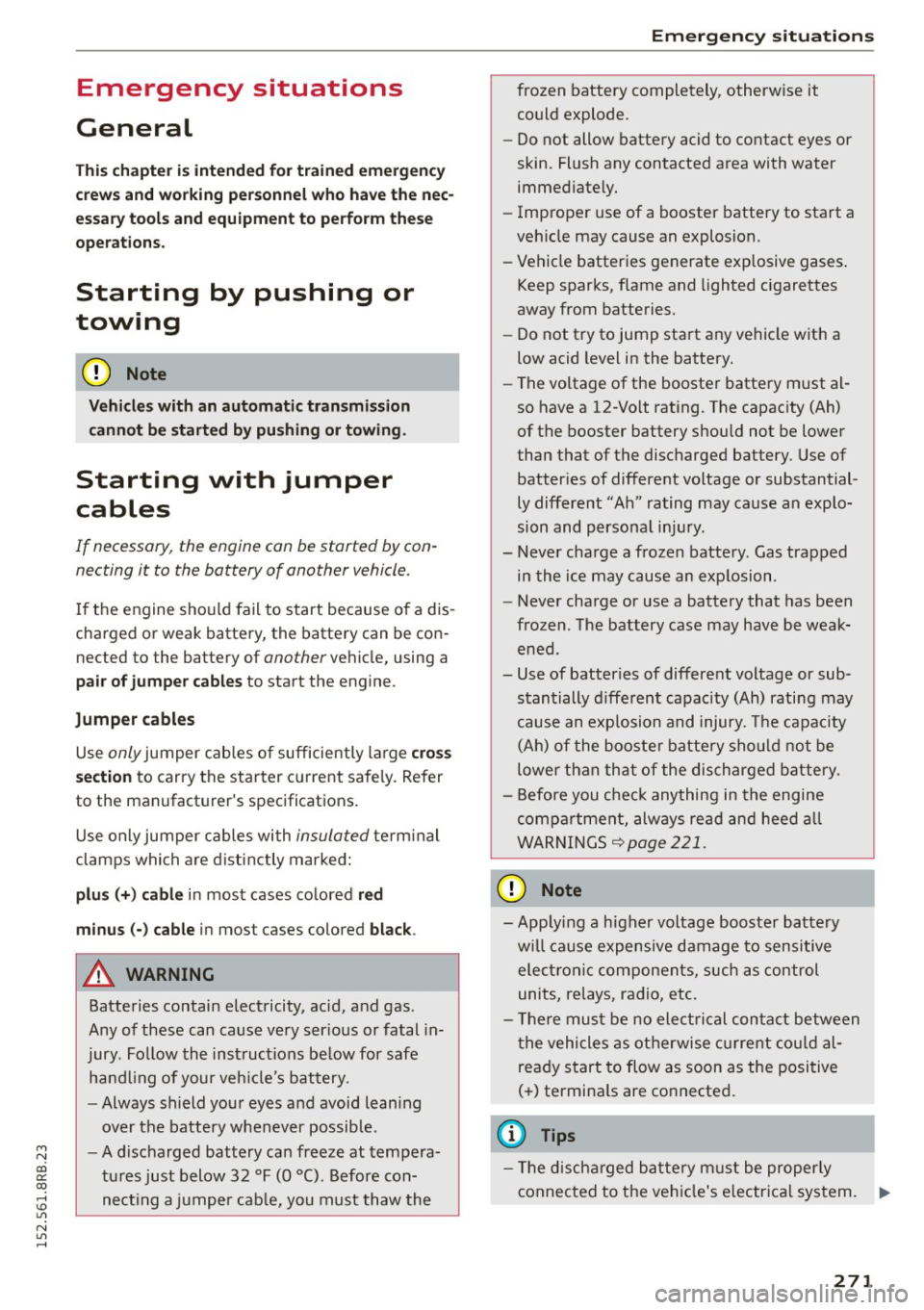
M N
co
a:
co
,...., \!) 1.1"1
N 1.1"1 ,....,
Emergency situations
General
This chapter is intended for trained emergency
crews and working personnel who have the nec
essary tools and equipment to perform these
operations.
Starting by pushing or
towing
(D Note
Vehicles with an automatic transmission
cannot be started by pushing or towing.
Starting with jumper
cables
If necessary, the engine can be started by con
necting it to the battery of another vehicle.
If the engine should fail to start because of a dis
charged or weak battery, the battery can be con
nected to the battery of
another vehicle, using a
pair of jumper cables to start the engine .
Jumper cables
Use only jumper cables of sufficiently large cross
section
to carry the starter current safely. Refer
to the manufacturer's specifications.
Use only jumper cables with
insulated terminal
clamps which are distinctly marked:
plus(+) cable in most cases colored red
minus(-) cable
in most cases colored black.
A WARNING
Batteries contain electricity, acid, and gas.
Any of these can cause very serious or fatal in
jury . Follow the instructions below for safe
handling of your vehicle's battery.
-Always shield your eyes and avoid leaning
over the battery whenever possible.
-A discharged battery can freeze at tempera
tures just below 32 °F (0 °C). Before con
necting a jumper cable, you must thaw the
Emergency situations
frozen battery completely, otherwise it
could explode.
- Do not allow battery acid to contact eyes or
skin. Flush any contacted area with water immediately.
- Improper use of a booster battery to start a
vehicle may cause an explosion.
- Vehicle batteries generate explosive gases.
Keep sparks, flame and lighted cigarettes
away from batteries.
- Do not try to jump start any vehicle with a
low acid level in the battery.
- The voltage of the booster battery must al
so have a 12-Volt rating. The capacity (Ah)
of the booster battery should not be lower
than that of the discharged battery. Use of
batteries of different voltage or substantial
ly different" Ah" rating may cause an explo
sion and personal injury.
- Never charge a frozen battery. Gas trapped
in the ice may cause an explosion.
- Never charge or use a battery that has been
frozen. The battery case may have be weak
ened ,
- Use of batteries of different voltage or sub stantially different capacity (Ah) rating may
cause an explosion and injury. The capacity
(Ah) of the booster battery should not be
lower than that of the discharged battery.
- Before you check anything in the engine
compartment, always read and heed all
WARNINGS
q page 221.
(D Note
-Applying a higher voltage booster battery
will cause expensive damage to sensitive
electronic components, such as control
units, relays, radio, etc.
- There must be no electrical contact between
the vehicles as otherwise current could al
ready start to flow as soon as the positive
(+) terminals are connected.
(D Tips
- The discharged battery must be properly
connected to the vehicle's electrical system. .,..
271
Page 274 of 302
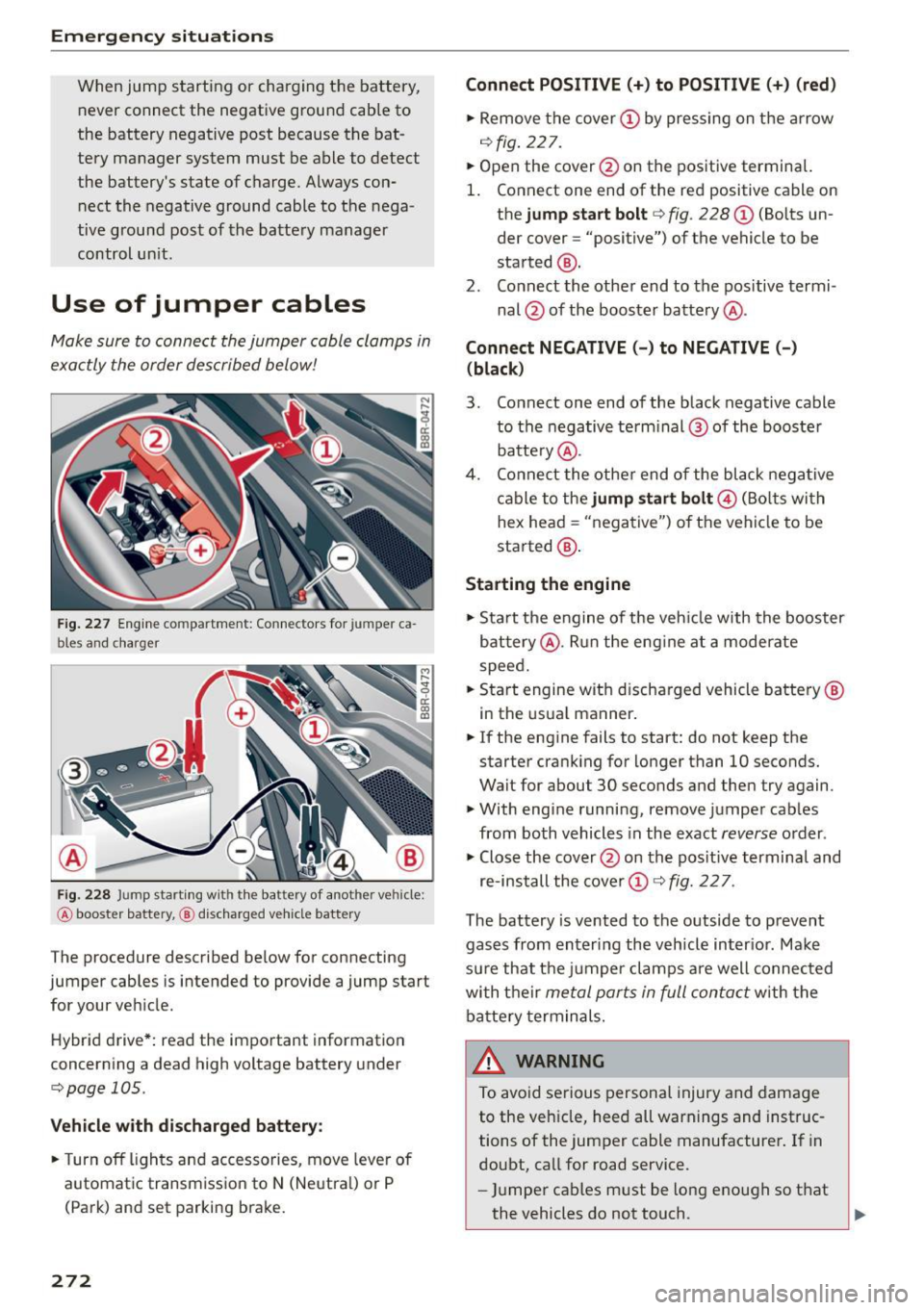
Emergency situation s
When jump starting or charging the battery,
never connect the negative ground cable to
the battery negative post because the bat
tery manager system must be able to detect
the battery's state of charge. Always con nect the negative ground cable to the nega
tive ground post of the battery manager
control un it.
Use of jumper cables
Make sure to connect the jumper cable clamps in
exactly the order described below!
Fig. 227 Engine co mpar tment : Connectors for ju mp er ca
bl es and charger
Fig. 228 Jum p starting wi th the battery of anot her ve hicl e:
@ booste r batte ry ,@ discharged vehicle battery
The procedure described be low for connecting
jumper cables is intended to provide a jump start for your vehicle.
Hybrid drive*: read the important information
concerning a dead high voltage battery under
c;,page 105.
Vehicle with discharged battery:
• Turn off lights and accessories, move lever of
automatic transmission to N (Neutral) or P
(Park) and set parking brake.
272
Connect POSITIVE(+) to POSITIVE (+) (red)
• Remove the cover (!) by pressing on the arrow
¢fig. 227.
• Open the cover @on the positive terminal.
1. Connect one end of the red positive cable on
the
jump start bolt c::> fig. 228 @ (Bolts un
der cover = "positive") of the vehicle to be
started @.
2 . Connect the other end to the positive termi-
nal @ of the booster battery @.
Connect NEGATIVE (-) to NEGATIVE (-)
(black)
3 . Connect one end of the black negative cable
to the negative terminal @ of the booster
battery @.
4. Connect the other end of the black negative
cable to the
jump start bolt © (Bolts with
hex head= "negative") of the vehicle to be
started @.
Starting the engine
• Start the engine of the vehicle with the booster
battery @. Run the eng ine at a moderate
speed.
• Start engine with discharged vehicle battery @
in the usual manner.
• lfthe engine fails to start: do not keep the
starter cranking for longer than 10 seconds.
Wait for about 30 seconds and then try again.
• With engine running, remove jumper cables
from both vehicles in the exact
reverse order .
• Close the cover @on the positive terminal and
re-install the cover@¢
fig. 22 7.
The battery is vented to the outside to prevent
gases from entering the vehicle interior . Make
sure that the jumper clamps are well connected
with their
metal parts in full contact with the
batte ry terminals.
& WARNING
To avoid serious personal injury and damage
to the veh icle, heed all warnings and instruc
tions of the jumper cable manufacturer. If in
doubt, call for road service.
- Jumper cables must be long enough so that
the vehicles do not touch. ..,.
Page 275 of 302
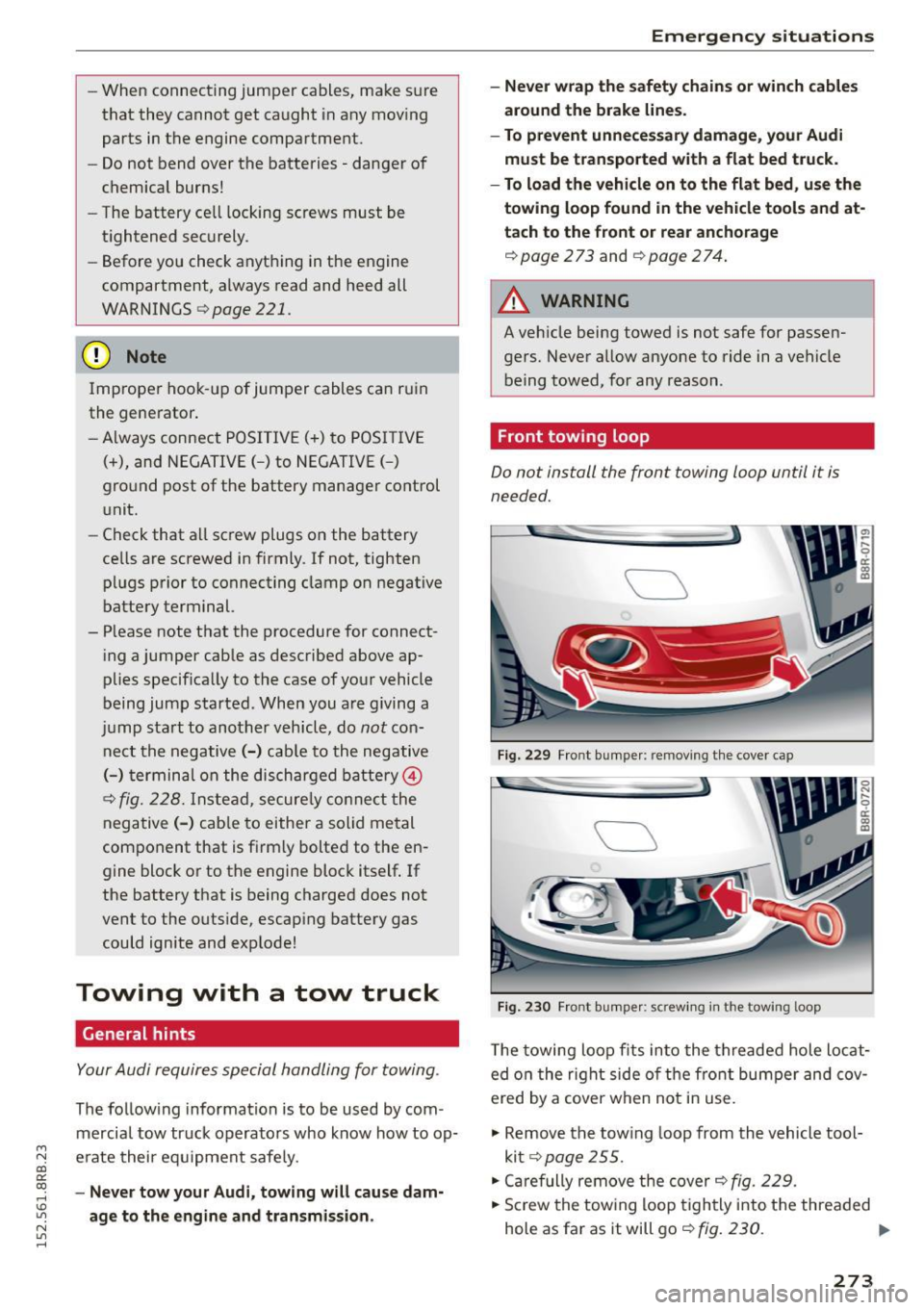
M N
co ~ co
rl I.O
"' N
"' rl
-When conne cting jump er cabl es, make sur e
that they cannot get caught in any moving
parts in the engine compartment.
- Do not bend over the batteries -danger of
chemical burns!
- The battery cell locking screws must be
tightened securely .
- Before you check anything in the engine
compa rtment, always read and heed all
WARNINGS
¢ page 221.
(D Note
Improper hook-up of jumper cables can ruin
the generator.
- Always connect POSITIVE(+) to POSITIVE
(+), and NEGATIVE(-) to NEGATIVE(-)
ground post of the battery manager control
unit.
- Check that all screw plugs on the battery
cells are screwed in firmly . If not, tighten
plugs prior to connecting clamp on negative
battery terminal.
- Please note that the procedure for connect
ing a jumper cable as described above ap
plies specifically to the case of your vehicle
being jump started . When you are giving a
jump start to another vehicle, do
not con
nect the negative(-) cable to the negative
(-) terminal on the discharged battery@
¢
fig. 228. Instead, securely connect the
negative (-) cable to either a solid metal
component that is firmly bolted to the en
gine block or to the engine block itself. If
the battery that is being charged does not
vent to the outside, escaping battery gas
could ignite and explode !
Towing with a tow truck
General hints
Your Audi requires special handling for towing .
The following information is to be used by com
mercial tow truck operators who know how to op
e rate their equipment safely .
-Never tow your Audi, towing will cause dam
age to the engine and transmission.
Emergency situations
- Never wrap the safety chains or winch cables
around the brake lines.
- To prevent unnecessary damage, your Audi
must be transported with a flat bed truck.
- To load the vehicle on to the flat bed, use the
towing loop found in the vehicle tools and at
tach to the front or rear anchorage
¢ pag e 273 and ¢ pag e 274.
A WARNING
--
A vehicle being towed is not safe for passen
gers. Never allow anyone to ride in a vehicle
being towed, for any reason .
Front towing loop
Do not install the front towing loop unt il it is
needed.
Fig. 229 Fro nt bump er: r em oving th e cover ca p
.·~G
' -
Fig. 230 Fro nt bumper: s crewing in th e tow in g l oo p
The towing loop fits into the threaded hole locat
ed on the right side of the front bumper and
cov
ered by a cover when not in use.
.,. Remove the towing loop from the vehicle tool
kit ¢
page 255.
"' Carefully remove the cover ¢ fig. 229 .
.,. Screw the towing loop tightly into the threaded
hole as far as it will go¢
fig. 230. IJi,,
273
Page 278 of 302
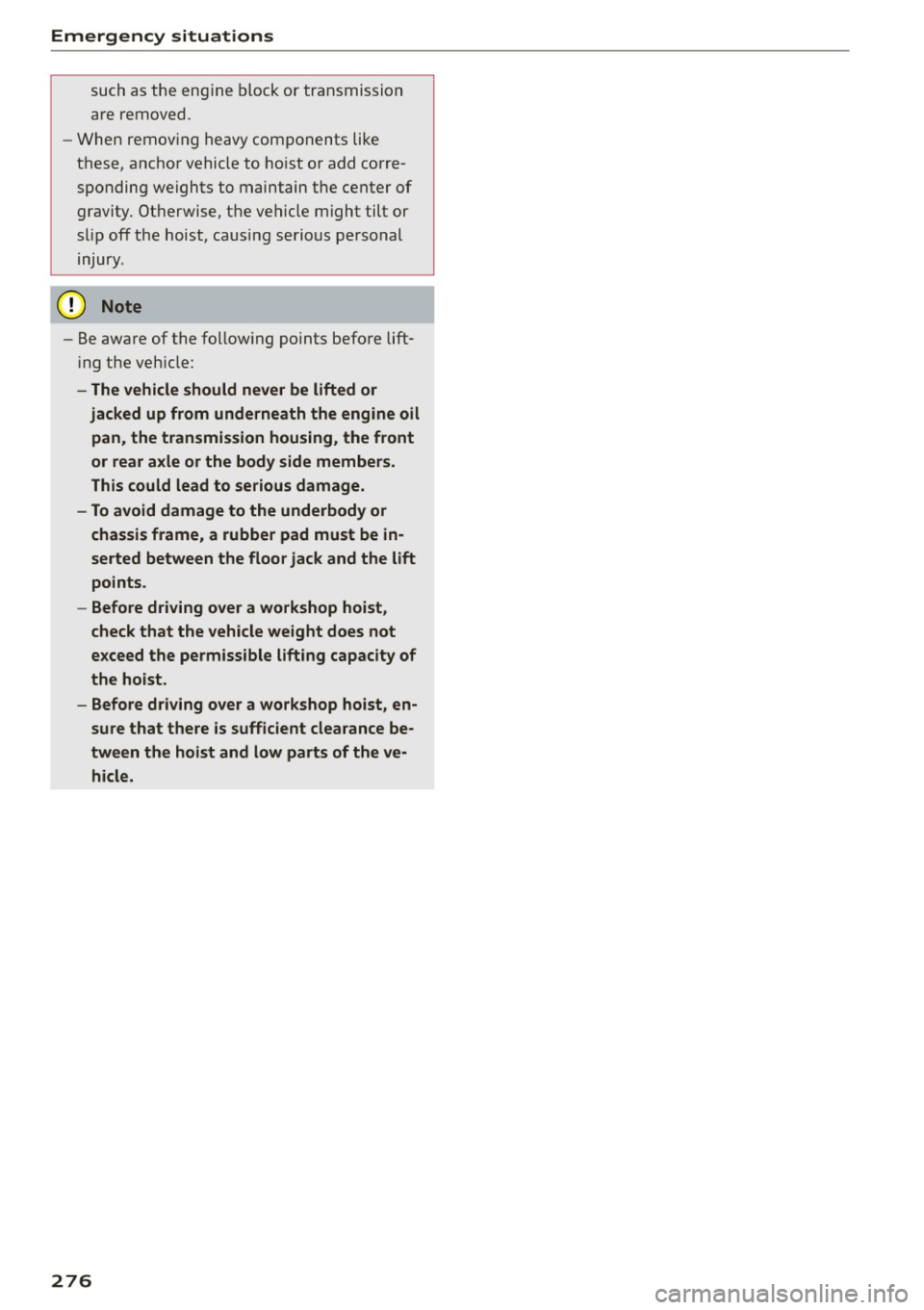
Emergency situations
such as the engine b lock or transmission
are removed .
- When remov ing heavy components like
these, anchor vehicle to ho ist or add corre
sponding weights to maintain the center of
gravity . Otherwise, t he vehicle might tilt or
slip off t he hoist, causi ng serious pe rsonal
injury .
(D Note
-Be awa re of the fo llow ing points befo re lift
ing the ve hicle:
- The vehicle should never be lifted or
jacked up from underneath the engine oil pan , the transmi ssion housing, the front
or rear axle or the body side members.
This could lead to se rious damage.
- To avoid damage to the underbody or chassis frame, a rubbe r pad must be in
serted between the floor jack and the lift
po ints .
- Before driving over a workshop hoist,
check that the vehicle weight does not
ex ceed the permissible lifting capacity of
the hoist.
- Before driving over a workshop hoist, en
sure that there is sufficient clearance be
tween the hoist and low parts of the ve
hicle .
276
Page 279 of 302

M N
co ~ co
rl I.O
"' N
"' rl
Technical data
Vehicle identification
F ig. 236 Veh icle Identificat ion Number (VlN) plate: loca·
t ion on driver 's side dash pane l
XXXXX XX -X -XXXX XXX XX
CD+ ~t :1:: xxxxxxxx xx x xxxxxxxx
T VP /fffl XXX XXX
XX XXXXXXX XX X X XX
XXX
KW XXX
®i ~:J ·f lfils~~ XXXX XXX XXX
®-+ ~ N:a=i~l xxxx ; xxxx xxx ; xx
11. • AUSS, I OPTIONS
E0A 7D5 4UB 6XM 5SG 5R W
2EH J0Z lLB l
A S lBA
3FC SMU 7Xl
FOA
9G3 0G7 0YH OJF
TL 6 3 KA
8EH UlA X98 QZ 7
lXW 803 908 824 020
7T6 CV7 7K0 4X3 2K2
3L4 4KC 3Y0 413 502
lS A
7GB 01A 4G0
XX. X XX X XX X xxxx
Fig. 237 Veh icle identificat ion label: inside the luggage
compartment
Vehicle Identification Number (VLN )
The Veh icle Iden tific ation Number is located in
d iffe rent p laces:
- under the w indshield on the dr iver's side
c::> fig . 236.
-in the radio or in the MM I*: Select: I CAR I func
t ion but ton
> Vehicle ID numb er (VIN ) or se·
Le et
I CAR I funct ion button > Car sy s tem s* con·
tro l bu tton
> Servicing & checks > VIN num
ber .
-on the vehicle identific ation label.
Technical d ata
Vehicle id entification label
T he vehicle identification label is lo cate d in the
lu ggage compartment above the compartment
for the vehicle too ls.
T he label
c::> fig . 23 7 shows the fo llow ing vehicle
da ta:
(D Vehicl e Ident ificat ion Number (VIN)
@ Vehicle type, engine o utp ut, transmission
@ Engine and transm ission code
@ Pain t number and inte rior
® Optional equipment numbers
T he information of the vehicle identification label
can a lso be found in your W arranty
& Ma inte
nance booklet.
Safety compliance sticker
T he safety complianc e sticker is your assurance
that your new vehi cle complies w ith all appli cable
F ede ra l Mo to r Vehi cle Safety Sta ndards which
were in effec t at the time the vehicle was ma nu
fact ured. Yo u can find this sticker on the door
jamb on the driver's side. It shows the month and year of product ion and the vehicle identification
number of your vehicle (perforation) as well as
t h e Gross Veh icle Weight Rating (GVWR) and the
G ross Ax le Weight Rating (GAWR).
H igh vo lt a ge warn ing lab el
The high voltage warning label is located in the
engi ne compartment next to the engine hood re·
lease. The spark ignit ion system complies with
the Canadian standard ICES-002 .
Weights
Gross Vehicle Weight Rating
The Gross Vehicle Weight Rating (GVWR), and
the Gross Axle Weight Rat ing (GAWR) for front
and rear are listed o n a sticker on the door jamb
on the dr iver's side.
The Gross Vehicle Weight Rating includes the
weight of the bas ic vehicle plus full fuel tank, oil
and coolant, plus maximum load, which includes
passenger weight (150 lbs/68 kg per designated
seat ing pos ition) and luggage we ight
c::> .&, . ..,_
277
Page 281 of 302
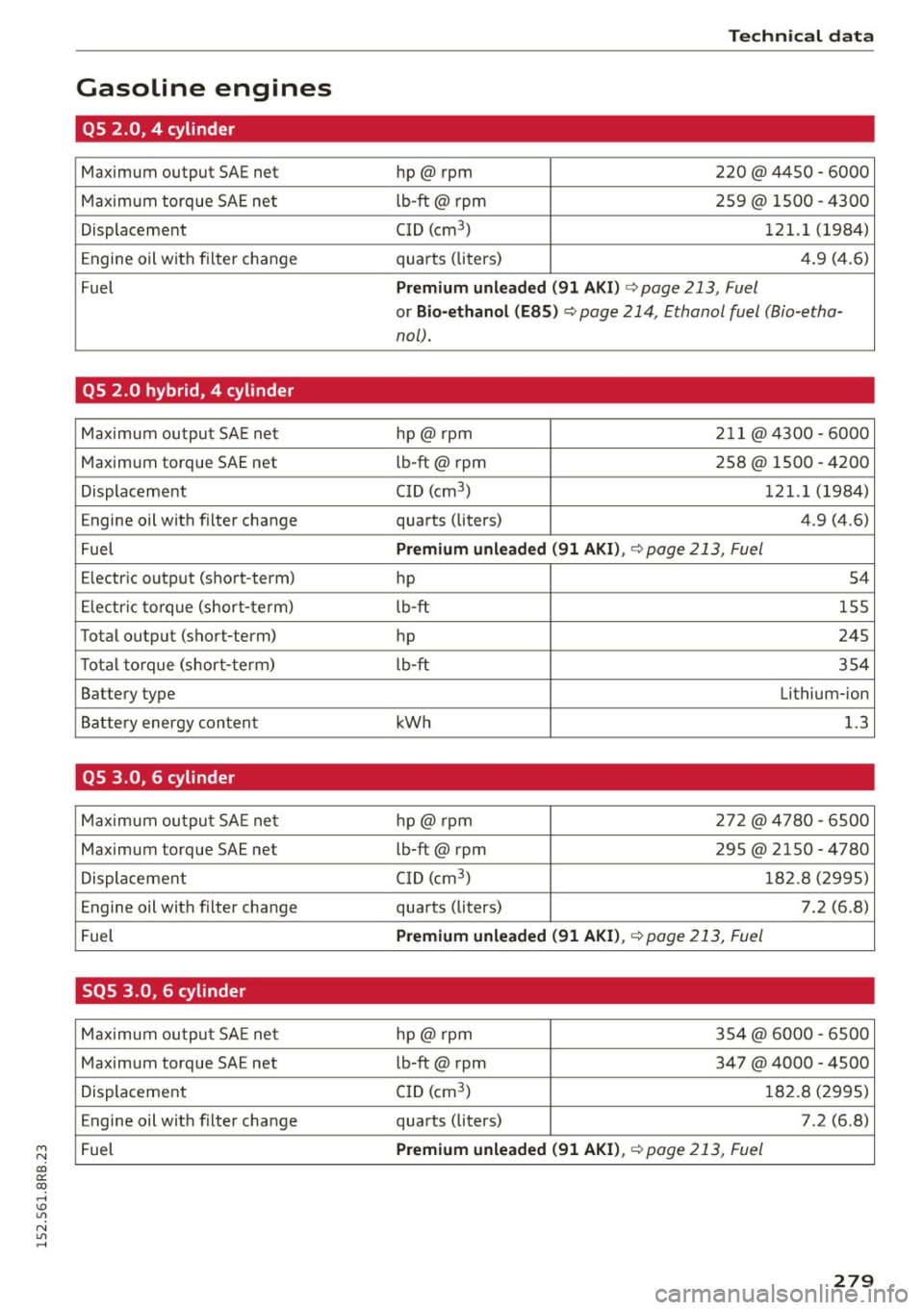
M N
co
a:
co
,...., \!) 1.1'1
N 1.1'1 ,....,
Gasoline engines
QS 2.0, 4 cylinder
Maximum output SAE net
Maximum torque SAE net
Displacement
Engine oil with filter change
Fuel
QS 2 .0 hybrid, 4 cylinder
Maximum output SAE net
Maximum torque SAE net
Displacement
Engine oil with filter change
Fuel
E lectric output (short-term)
E lectr ic torque (short-term)
Total output (short-term)
T otal torque (short-term)
Battery type
Battery energy content
QS 3.0, 6 cylinder
Maximum output SA E net
Maximum torque SAE net
Displacement
Engine oil with f ilter change
Fuel
SQS 3.0, 6 cylinder
Maximum output SA E net
Maximum torque SAE net
Displacement
Engine oil with filter change
Fuel
Techni cal d at a
hp@rpnn 220 @4450 -6000
lb -ft@ rpm 259@ 1500 -4300
CID (cm
3 ) 121.1 (1984)
quarts (liters) 4.9 (4.6)
Premium un lead ed (9 1 A KI) <=:>pag e 213, Fuel
or
Bi o-e tha no l (E B S) ¢ page 214, Ethanol fuel (Bio-etha-
no[) .
hp@rpnn 211 @4300 -6000
lb -ft@ rpm 258 @ 1500 -4200
CID (cm
3 ) 121.1 (1984)
quarts (liters) 4.9 (4.6)
Premium unl ead ed (91 AKI) , <=:>page 213, Fuel
hp 54
lb -ft 155
hp 245
lb-ft 354
Lithium-ion
kWh 1.3
hp@ rpnn 272@ 4780 -6500
lb-ft@ rpm 295@ 2150 -4780
C ID (cm
3
') 182.8 (2995)
quarts (liters) 7.2 (6.8)
Pre mi um unl ead ed (9 1 AKI) , <=:>page 213, Fuel
hp@ rpnn 354@ 6000 -6500
lb-ft@ rpm 347 @4000 -4500
C ID (cm
3
) 182.8 (2995)
quarts (liters) 7.2 (6.8)
Pre mium unlea ded (91 A KI) , <=:> page 213, Fuel
279
Page 282 of 302
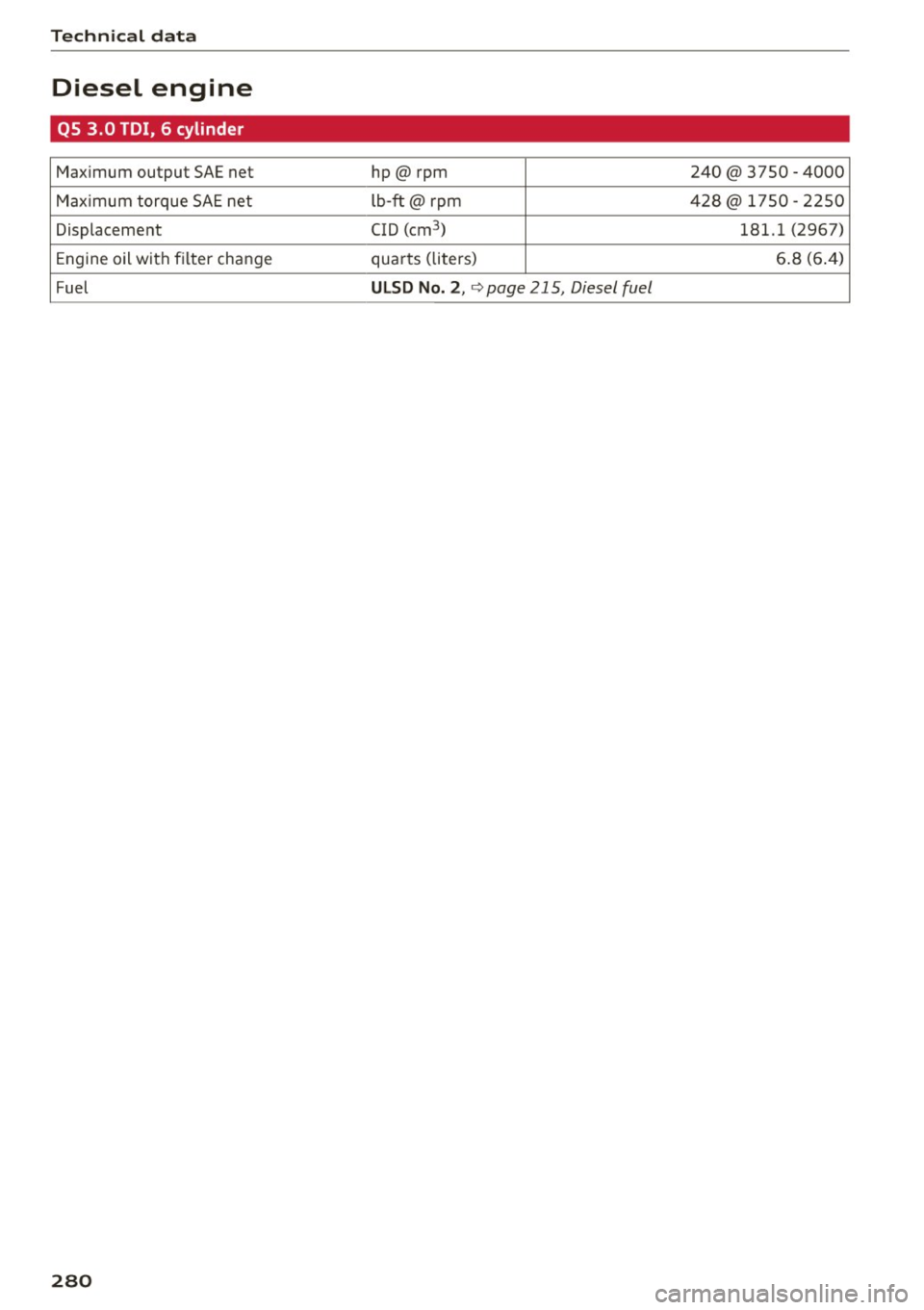
Technical data
Diesel engine
QS 3.0 TDI, 6 cylinder
Maximum output SAE net hp@rpm 240@ 3750 - 4000
Maximum torque SAE net lb-ft @ rpm 428@
1750 -2250
Displacement CID (cm
3
) 181.1 (2967)
Engine oil with filter change quarts (liters)
6.8 (6.4)
Fuel
ULSD No. 2, ¢ page 215, Diesel fuel
280
Page 283 of 302
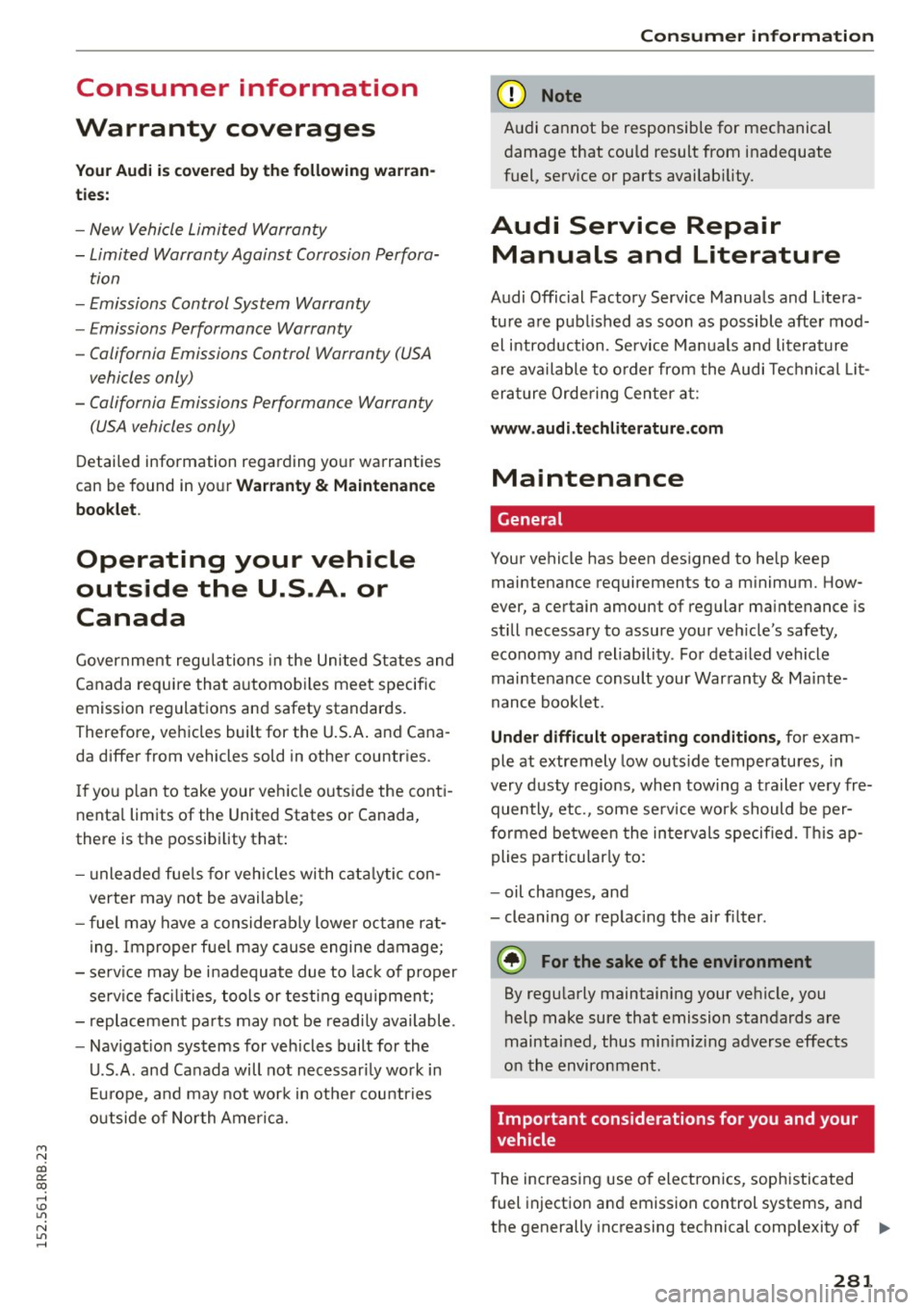
M N
co
a:
co
,...., \!) 1.1"1
N 1.1"1 ,....,
Consumer information
Warranty coverages
Your Audi is covered by the following warran
ties:
- New Vehicle Limited Warranty
- Limited Warranty Against Corrosion Perfora-
tion
- Emissions Control System Warranty
- Emissions Performance Warranty
- California Emissions Control Warranty (USA
vehicles only)
- California Emissions Performance Warranty
(USA vehicles only)
Detailed information regarding your warranties
can be found in your
Warranty & Maintenance
booklet .
Operating your vehicle
outside the U.S.A. or
Canada
Government regulations in the United States and
Canada require that automobiles meet specific
emission regulations and safety standards.
Therefore, vehicles built for the U.S.A. and Cana
da differ from vehicles sold in other countries.
If you plan to take your vehicle outside the conti
nental limits of the United States or Canada,
there is the possibility that:
- unleaded fuels for vehicles with catalytic con
verter may not be available;
- fuel may have a considerably lower octane rat
ing . Improper fuel may cause engine damage;
- serv ice may be inadequate due to lack of proper
serv ice faci lities , tools or testing equipment;
- replacement parts may not be readily available .
- Nav igat ion systems for vehicles built for the
U.S.A. and Canada will not necessar ily work in
Europe , and may not work in other countries
outside of North America.
Consumer information
(D Note
Audi cannot be responsible for mechanical
damage that could result from inadequate
fuel, service or parts availability.
Audi Service Repair
Manuals and Literature
Audi Official Factory Service Manuals and Litera
ture are published as soon as possible after mod el introduction . Service Manuals and literature
are available to order from the Audi Technical Lit
erature Ordering Center at:
www.audi.techliterature.com
Maintenance
General
Your vehicle has been designed to help keep
maintenance requirements to a minimum. How
ever, a certain amount of regular maintenance is
still necessary to assure your vehicle's safety,
economy and reliability. For detailed vehicle
maintenance consult your Warranty & Mainte
nance booklet .
Under difficult operating conditions, for exam
ple at extremely low outside temperatures, in
very dusty regions, when towing a trailer very fre
quently, etc., some serv ice work should be per
formed between the intervals specified. This ap
plies particularly to:
- oil changes, and
- cleaning or replacing the air filter .
(® For the sake of the environment
By regularly maintaining your vehicle, you
help make sure that emission standards are
maintained, thus min imizing adverse effects
on the environment.
Important considerations for you and your
vehicle
The increasing use of electronics, sophisticated
fuel injection and emission control systems, and
the generally increasing technical complexity of
lllJ,,
281
Page 284 of 302
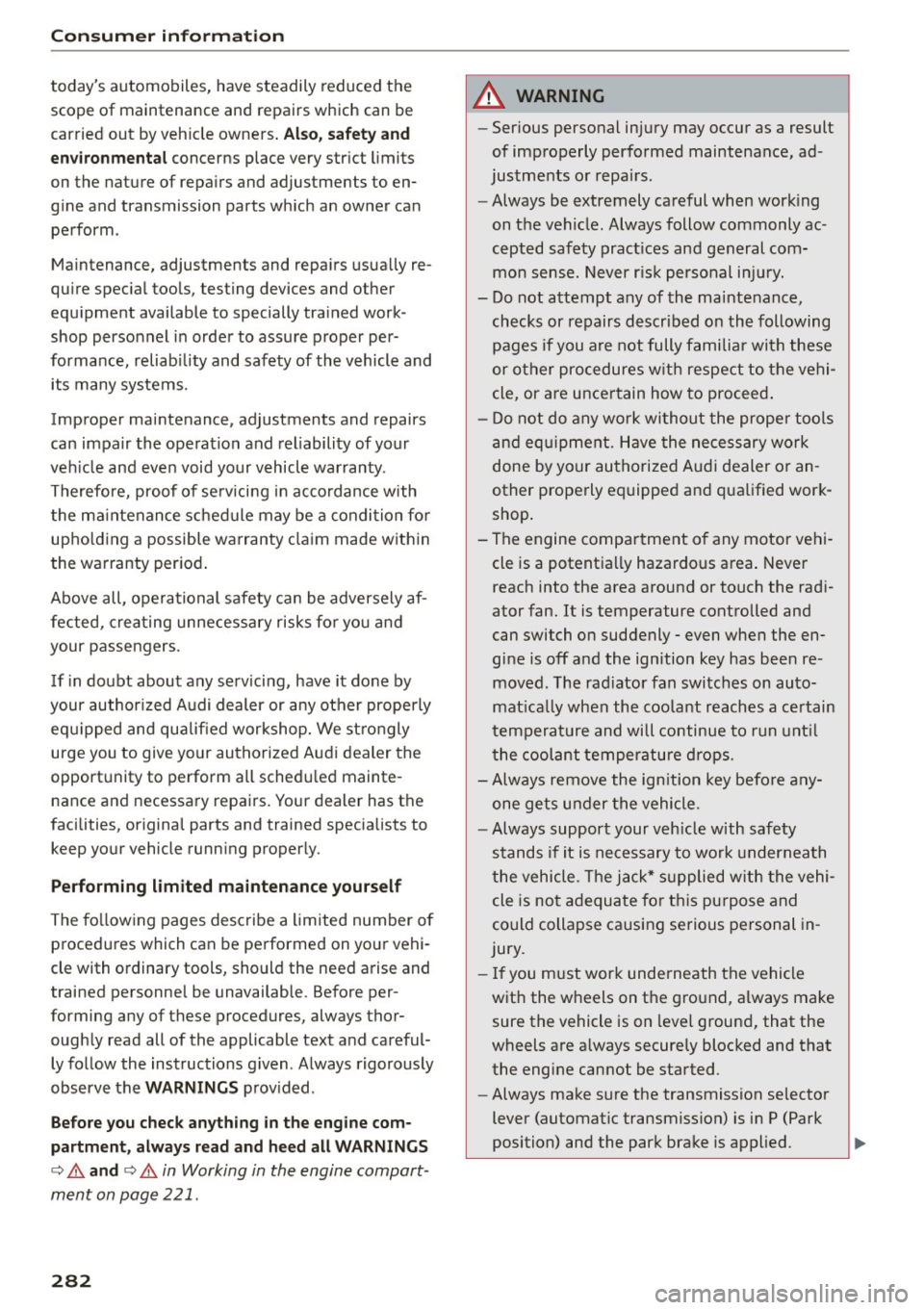
Consumer information
today's automobiles, have steadily reduced the
scope of maintenance and repairs which can be
carried out by vehicle owners.
Also, safety and
environmental
concerns place very strict limits
on the nature of repairs and adjustments to en
gine and transmission parts which an owner can perform .
Maintenance, adjustments and repairs usually re
quire special tools , testing devices and other
equipment available to specially trained work
shop personnel in order to assure proper per
formance, reliability and safety of the vehicle and its many systems.
Improper maintenance, adjustments and repairs
can impair the operation and reliability of your
vehicle and even
void your vehicle warranty .
Therefore, proof of servicing in accordance with
the maintenance schedule may be a condition for
upholding a possible warranty claim made within
the warranty period .
Above all, operational safety can be adversely af
fected, creating unnecessary risks for you and
your passengers.
If in doubt about any servicing, have it done by
your authorized Audi dealer or any other properly equipped and qualified workshop. We strongly
urge you to give your authorized Audi dealer the
opportunity to perform all scheduled mainte nance and necessary repairs. Your dealer has the
facilities, original parts and trained specialists to keep your vehicle running properly.
Performing limited maintenance yourself
The following pages describe a limited number of
procedures which can be performed on your vehi
cle with ordinary tools, should the need arise and
trained personnel be unavailable. Before per
forming any of these procedures, always thor
oughly read all of the applicable text and carefully follow the instructions given . Always rigorously
observe the
WARNINGS provided.
Before you check anything in the engine com
partment, always read and heed all WARNINGS
c::> & and c::> & in Working in the engine compart
ment on page 221 .
282
A WARNING
-
-Serious personal injury may occur as a result
of improperly performed maintenance, ad
justments or repairs.
- Always be extremely careful when working
on the vehicle . Always follow commonly ac
cepted safety pract ices and general com
mon sense. Never risk personal injury.
- Do not attempt any of the maintenance,
checks or repairs described on the following
pages if you are not fully familiar with these
or other procedures with respect to the vehi
cle, or are uncertain how to proceed.
- Do not do any work without the proper tools
and equipment. Have the necessary work
done by your authorized Audi dealer or an
other properly equipped and qualified work
shop.
- The engine compartment of any motor vehi cle is a potentially hazardous area. Never
reach into the area around or touch the radi
ator fan. It is temperature controlled and
can switch on suddenly - even when the en
gine is off and the ignition key has been re
moved. The radiator fan switches on auto
mat ically when the coolant reaches a certain
temperature and will continue to run until
the coolant temperature drops.
- Always remove the ignition key before any
one gets under the vehicle.
-Always support your vehicle with safety
stands if it is necessary to work underneath
the vehicle. The jack* supplied with the vehi
cle is not adequate for this purpose and
could collapse causing serious personal in
jury.
- If you must work underneath the vehicle
with the wheels on the ground, always make
sure the vehicle is on level ground, that the
wheels are always securely blocked and that
the engine cannot be started.
- Always make sure the transmission selector
lever (automatic transmission) is in P (Park
position) and the park brake is applied.